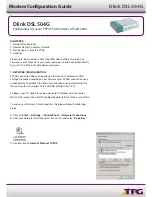
9
CHAPTER 2: Overview
2. Overview
2.1 Introduction
With the Modem Router Switch, you can switch inbound modem calls to any of
eight receiving modems (PCs, servers, etc.) that the caller selects. Designed
primarily for modem applications, you can also use it for voice, fax, or other analog
switching applications. The switch also enables you to switch devices on outbound
telephone lines. Or, you can simply reboot your PC using the optional power
adapter (40420).
The Modem Router Switch has two telco line connections and eight modem ports.
2.1.1 I
NBOUND
C
ALLS
When used to route inbound calls, the caller selects the desired port when placing
the call. The Modem Router Switch’s two primary operating modes (Touch-tone
and Secure) enable the call routing. Select the desired operating mode via a rotary
switch (see Figure 2-2 and Table 2-2 on pages 12–16).
The Touch-tone mode provides a simple DTMF tone port selection method. The
caller simply enters a password and the desired port number. You can do this
manually from any touch-tone keypad or by appending the proper character
sequence to the “AT Commands” for dialup modem applications.
The Secure mode requires a matchbox-size Security Selection Key (part number
40419) with an eight-position rotary selector switch that connects to the caller’s
modem. The security device encrypts the handshake with the Modem Router
Switch and automatically switches the call to the selected port. Any call received
without the proper corresponding Security Key aborts within a half second. This
eliminates wrong numbers and nuisance calls. Calls by any of the “hacker” type
War Dialers are also not recognized as a modem.
2.1.2 O
UTBOUND
C
ALLS
For outbound calls, the Modem Router Switch also acts as a telephone line switch.
Any of the “switched ports” may bid for the available telco line simply by going off-
hook. If the line is already in use by another inbound or outbound call, the
bidding modem receives no dial tone.
Summary of Contents for 40418
Page 3: ......











































